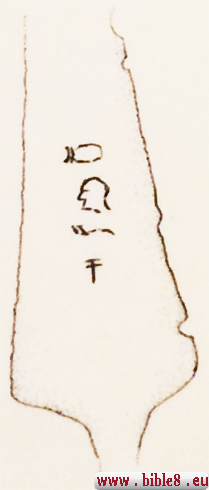
The History of Biblical Script
From Ancient Alphabets to Square Script
Bibel-Epigraphik
Among the most important inventions of humanity – such as the wheel, arrows, money, and the boomerang – the invention of recording human speech is undoubtedly among the oldest texts of the Bible.
Did the history of the Bible as a written text begin with the Ten Commandments on two stone tablets? Most likely not.
Legends tell that after Abraham gave a tithe to Melchizedek, he received some writings from him. It is believed that these might have been texts about the creation of the world or even all the Elohim texts (fragments of the Torah where God is called "Elohim"). It appears that earlier Eastern texts (often called the Priestly Code) were used as sources for the first chapters. For example, an Assyrian fragment (CT XIII, 34) shows the sequence of acts of creation in the same order as Genesis 1, including the creation of man as the crown of creation.
We are currently talking about the first half of the book of Genesis: here, pieces of text in which God is called either "Elohim" or exclusively "Lord" (Tetragrammaton - the name of God YHWH) stand side by side very clearly. It creates the impression that an editor had two piles of finished texts about the same events, either from two different authors or from the same author written at different times. The editor "glued" them together to maintain the narrative flow.
In the text of the Ten Commandments, both names of God appear: "Elohim" and "Lord." The Decalogue undoubtedly represents a coherent text.

These letters were drawn when the alphabet had only recently been created, and at that time each letter was drawn according to their image. This writing may be almost contemporary (perhaps 40-50 years later) with the stone tablets that Moses was supposed to receive from God on Mount Sinai.
The stone tablets were most likely not written in the modern square script. The current square script was brought from the Babylonian captivity — as the Talmudic literature reports — and is therefore called the "script of Ezra." It is called "square" because the Hebrew letters harmoniously fit into a square. Only one letter, "L" – called LAMED in Hebrew, from the verb "to learn" – extends beyond the imaginary square, symbolizing, according to Jewish scholars, that learning leads a person beyond his boundaries.
The Samaritans were not in captivity, were a separate people at the time of Ezra, and preserved their own version of the Pentateuch. Hence, the logical question: did the Samaritans also preserve the ancient script in which the tablets may have been written? Some Talmudic texts support this theory. The rabbis assert that before the exile, the Jews used an ancient script resembling the Samaritan one. After the exile, Ezra replaced it with a new script of Assyro-Chaldean origin.
Modern scholars raise questions: "Should the ancient, truly Jewish script be called Assyrian simply because Ezra popularized it after returning from Chaldea? It seems more likely that it was the script of the Assyrians and Chaldeans themselves. Should Samaritan script be called Jewish because it was used by common people among the Jews? Were they any less Jewish?" (Gesenius)
In religious texts, some Hebrew letters are adorned with a crown (Tagin). According to Jewish tradition, God Himself decorated the writings with crowns before giving the Law to Moses. However, in the text of the Decalogue (the Ten Commandments), written by God Himself, the letter "Yod" is missing, which for a long time was not considered a letter but just a small mark. We learn about this from the Gospels when Jesus said: "until heaven and earth pass away, not one jot or one tittle will by no means pass from the law until all is fulfilled." (Matthew 5:18).
Nevertheless, "Yod" in the Torah is adorned with a crown, as are six other letters, which may indicate that Moses did not directly adopt this decoration from the tablets.
Paleographers find similar crown-like elements in Moabite inscriptions:
The scholar Buxtorf had a different opinion, namely, that the Jews had two scripts: the sacred square script and the everyday coin script. The square script was considered the oldest alphabet of the Jews. Even before the captivity, the Samaritan script was used for everyday needs. Ezra popularized the square script, which became known as the Assyrian script. The Samaritans, however, preserved the ancient form of writing.
To support this theory, one can point to the fact that neighboring peoples also had different types of writing in use. The Egyptians had two types of writing: sacred and epistolary. The Persians and Medes used cuneiform for monuments and Zend script for everyday life. Even Arabs, Persians, and Turks used different scripts for letters, poetry, and chronicles. Similarly, in Holy Scripture there are verses that might hint at this: In the book of Isaiah 8:1 it is said that God tells the prophet to "take a large scroll and write on it with a human script." Is there a distinction here between the scripts used in everyday Jewish life and the "non-human" or "divine," "religious" scripts used for sacred writings? It is interesting to compare this with the texts in Revelation 13:18 and 21:17, where there is mention of a human number and a human measure. Furthermore, in Habakkuk 2:2, God commands the prophet to "write the vision clearly on tablets so that a runner may read it," emphasizing the need for clarity.
Another researcher's opinion – Löscher: "It is hard to imagine that Ezra, so committed to tradition, would have accepted a new script from the hated Chaldeans."
Gesenius, the author of the Symphony on the Old Testament in its original language, wrote: "Many have argued whether Moses had the original alphabetic script – Samaritan or Chaldean. But probably both assumptions were wrong." I would add that Gesenius's assumptions about the appearance of biblical writing in the late First Christian era, as outlined in his 1815 book "History of the Hebrew Language and Writing," are now considered to be 25–30% inaccurate thanks to the findings at Qumran.
Here are more scholars' reflections on writing: Alfred Jeremias said: "The highest indicator of a country's level of culture is its writing system. We must assume that Moses, 'educated in all the wisdom of the Egyptians' (Acts 7:22), wrote using cuneiform, as was done by the kings of Canaan and the Pharaohs of Egypt in their dealings with the Near East."
Johannes Lehmann: "Generations of Pharaohs built a temple at Serabit el-Khadim, leaving inscriptions there. Besides hieroglyphs, inscriptions in Proto-Sinaitic script were also found there..." "After the victory over the Amalekites at Rephidim, the word 'to write' is mentioned for the first time in the Bible: 'Then the Lord said to Moses, 'Write this on a scroll as something to be remembered...'' Interestingly, the valley near Serabit el-Khadim is called Wadi Mukattab — 'the valley of inscriptions.' Flinders Petrie discovered inscriptions there that became a precursor to the alphabet."
In 1915, British Egyptologist Alan Gardiner proved that the Proto-Sinaitic script found at Serabit el-Khadim derived from Egyptian hieroglyphs but already represented a phonetic script – around 1500 BC.
Frame from the film 'The Exodus Decoded'. Images of a fish, water, and a bull's head are visible on the rock. In modern Hebrew, the shapes have changed, but originally, thousands of years ago, they looked like the images on this rock. For example, the first letter of the alphabet is called Aleph, meaning 'bull' in ancient Hebrew, and it can be seen on this rock. The letter M in Hebrew, from the word Ma'im (water), is depicted on the rock as a wave.
The creator of the film "The Exodus Decoded," Simcha Jacobovici, sits in a cave where he believes Jewish slaves once worked in Ancient Egypt. He looks at an inscription left by someone in ancient Hebrew script: "God, save me!" He claims this is one of the archaeological proofs of the events described in the Pentateuch of Moses, indicating that Jews were once there. Ancient Egyptians practiced polytheism, while Jews were monotheists. Simcha Jacobovici, himself Jewish, is deeply moved to see not only an ancient Jewish prayer for help but also to be a modern descendant of the one who carved it.
2025
Donation
© 2012 - 2025
